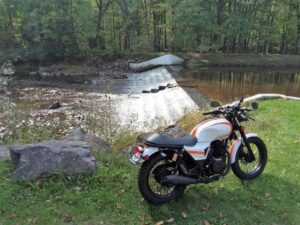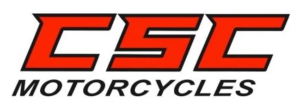Why many motorcycle riders choose smaller and less expensive cycles.
Motorcycles have gotten bigger, more complex, and MUCH more expensive. In the past, riders bought motorcycles to SAVE money! Today, many motorcycles cost MORE than economy cars – with financing terms to match!
But there are AFFORDABLE alternatives to high-tech, high-cost motorcycles! Look no farther than the SG250 from CSC Motorcycles.
The CSC SG250 San Gabriel reminds us why we love to ride. The San Gabriel is handsome, yet rugged. It has all essentials and intentionally avoids complications. The SG250 is equipped with a proven 230cc, single-cylinder, air-cooled engine. This small motorcycle is a throw-back to purist motor bike riding!
There are MANY reasons for intentionally downsizing and simplifying your choice of motorcycle:
1. Lower Purchase Cost for Small Motorcycles
Motorcycle manufacturers have followed the auto brands by continually offering bigger models with more expensive technology.
But new riders aren’t looking for $30,000 to $50,000 bikes. The fact is that your memories are made by the MILE and are not determined by the cost of the motorcycle. Do you see more scenery, sunsets, or wildlife?
NO – an affordable motorcycle might enable you to ride MORE and work LESS to cover the payments, helping you create MORE memories!
2. Lower Operating, Maintenance, Repair, and Insurance Costs of Small Motorcycles
Expensive motorcycles are as complex as modern automobiles.
In terms of maintenance and repairs, less expensive motorcycles are simpler and more accessible to the owner or an independent cycle shop. Generic parts and accessories typically don’t fit expensive motorcycles. Likewise, smaller, simpler motorcycles do not require premium gas.
A $2,500 or $5,000 motorcycle costs much less to insure than a $25,000 or $50,000 motorcycle.
Smaller, less expensive motorcycles are often purchased by riders who already have other bikes. It costs less to buy and own two (or three) smaller motorcycles than one over-priced hog!
3. Safer Riding on Small Motorcycles – Especially Older, Smaller, and Solo Riders
If you have experience riding a bigger motorcycle, smaller cycles will feel nimble and “flickable” in comparison.
With less mass you will have better control in corners, when braking, and in rough conditions. Simply parking on an uneven surface is impossible with huge motorcycles. Big, heavy motorcycles require perfect balance – because there is NO WAY you are going to pick up that 500-pound beast!
Smaller, lighter motorcycles are PERFECT for smaller and lighter riders – as well as older riders and anyone who rides solo.
4. The Simplicity and Minimalism of Riding Small Motorcycles
YES – you can tour on a smaller motorcycle!
Andrew Pain, the author of Going Small, advises getting off the freeway, setting a slower pace, and enjoying the journey. He encourages riders to choose the smallest motorcycle to cover the miles, and then pack as lightly as possible. Every gas stop and local meal will provide the opportunity for interactions with local residents.
Adopt the minimalism of bicycle touring for light, motorcycle touring – which I have dubbed “MotorBikePacking”
5. Display Your Maturity by Riding a Small Motorcycle
“Mature” riders (regardless of age) place less value on horsepower, speed, and noise.
Big or small, I am happy to cruise at 5 or 10 miles over the speed limit and seldom ride over 70 MPH. Much of my riding is on rural gravel roads where 25 to 40 miles per hour is the norm. I agree with the admonition: “Anything bigger than 250cc is just wheel spin.”
Small motorcycles are often labeled “beginner bikes”, but they will also extend the YEARS of riding that you enjoy.
Slow down. Take longer breaks, Enjoy a siesta. Start later, then quit earlier in the day. Remember: Less is More!
6. BONUS Reason: Riding Smaller Motorcycles Is FUN!
It’s not surprising that most small motorcycle buyers have previously owned or still own larger motorcycles.
The owners of multiple motorcycles readily admit that the one that they ride the most is their smallest motorcycle. Why? Because smaller, lighter motorcycles are pure fun!
A light cycle skips across rough road sections with less stress to the rider and the bike.
When riding a smaller motorcycle, you will voluntarily avoid the road rage on the freeway. Not only are you SEEING the scenery flow by, but you get to ENJOY the ride longer! In town, a smaller motorcycle maneuvers effortlessly through traffic.
The fun continues when you customize the SG250 to fit your style. Staring out from a BRAND NEW motorcycle under $2,500, you can transform the bike into a retro ride, hooligan racer, or back road scrambler!
The riders of smaller motorcycles are CONTRARIANS in our “Bigger is Better” culture. But they know the “secret” advantages of smaller motorcycles. Not only do they have full “memory banks” of tours and destinations, but they have more money in their wallets, too!
With a light, CSC SG250, you can ALSO take the FUN with you when you travel!
See more FUN rides by the members of the CSC SG250 Owners Group on Facebook. Learn more about the CSC SG250 and the other affordable motorcycles at CSCMotorcycles.com
Randy Reek is an experienced motorcycle rider who has toured from Key West to Alaska. He has ridden the Trans-American Trail and numerous Backcountry Discovery Routes. Over the years, he has owned dozens of cycles, from 50cc scooters to 1700cc cruisers – including FOUR CSC models! Randy divides his time between the Wisconsin woods and deserts of Arizona and Utah. You can follow his adventures at GreatOutThere.online and The Great Out There on YouTube, Facebook, and Instagram.
















































 SG250 San Gabriel Cafe Racer
SG250 San Gabriel Cafe Racer TT250 Enduro
TT250 Enduro RX1E Electric Motorcycle
RX1E Electric Motorcycle